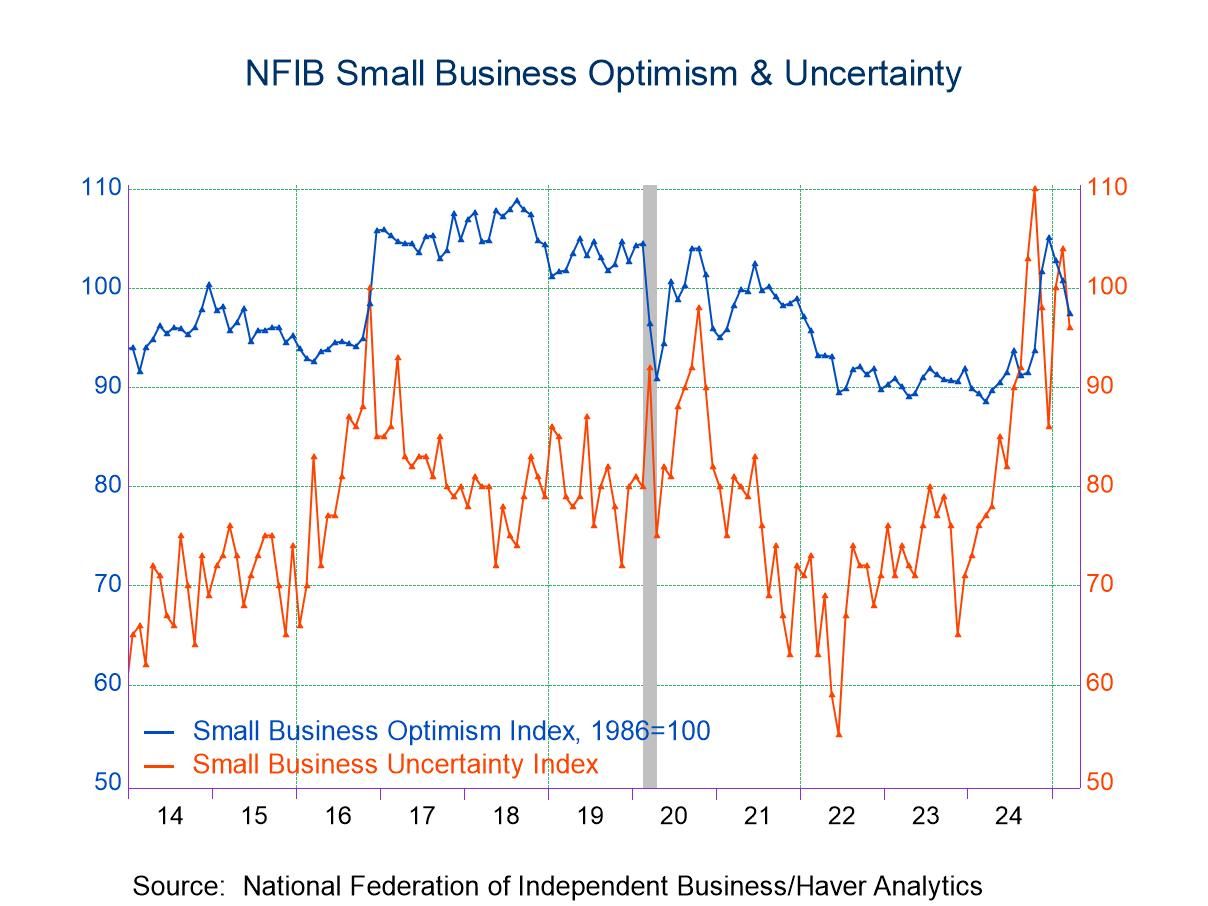- Inventories trend higher y/y.
- Sales surge broadly.
- Inventory-to-sales ratio continues to decline.
by:Tom Moeller
|in:Economy in Brief
- USA| Apr 09 2025
Mortgage Applications Surge as Rates Fall in Latest Week
- Refinanced loans nearly double; purchase loan applications are strong as well.
- Fixed-rate mortgages decline.
- Average loan size surges.
by:Tom Moeller
|in:Economy in Brief
- Japan| Apr 09 2025
Japan’s Confidence Falls and Stays Low
Japan’s confidence is still weak and in a down cycle. Since reaching a sharp peak early in 2024, confidence continues to recede. All components are showing decline on all horizons from 12-months to 6-months to 3-months. This is an extremely uniform response.
Consumer confidence has a 15-percentile standing on data back to 2004. Components of the confidence index has standing that range from a standing at the 47.8% mark for the valuation of assets to a low at the 6.1 percentile mark for willingness to purchase durable goods.
In keeping with this weakness, the overall livelihood standing is at its 10.2 percentile.
- Economic & sales expectations weaken.
- Employment plans fall but job openings rise.
- Prices decline but price expectations rise.
by:Tom Moeller
|in:Economy in Brief
- USA| Apr 08 2025
U.S. Energy Prices Are Mixed in Latest Week
- Gasoline prices strengthen.
- Crude oil prices fall.
- Natural gas costs rise.
by:Tom Moeller
|in:Economy in Brief
- Japan| Apr 08 2025
Japan’s Economy Watchers – Conditions Sag
Japan’s Economy Watchers Index saw its current and future indexes fall and indicated contraction in March. We can only imagine the knock-on effects of impending U.S. tariffs on these perceptions and expectations in the months ahead.
As it stands, Japan’s economy watchers survey show month-to-month attitude deterioration in their diffusion responses up and down the line. For the current conditions survey, entries erode except for eating & drinking places, manufacturers, and services. For the future index, all the responses are weaker month-to-month except for housing, corporations, and manufacturers.
In terms of percentile standings on survey responses from March 2004 to date, only one category in the current or future services, current manufacturers, has a reading above the 50% mark making it the lone response above its historic median on this timeline. It achieves this ‘milestone’ with a diffusion reading of 47.8, that nonetheless indicates contraction. Manufacturers also have the highest diffusion ranking in the future survey but at the below median 46.2 percentile mark; the topical diffusion reading of 47.4 indicates ongoing contraction.
- USA| Apr 07 2025
U.S. Consumer Credit Slips in February
- Nonrevolving credit declines slightly.
- Revolving credit edges up.
by:Tom Moeller
|in:Economy in Brief
 Asia| Apr 07 2025
Asia| Apr 07 2025Economic Letter from Asia: Just Tariffic
This week, we focus on the sweeping "reciprocal" US tariffs announced by President Trump last week. As shown in chart 1, these tariffs are primarily based on US trade deficits with its trading partners. This is in contrast to earlier indications that suggested other factors, such as tariff and non-tariff barriers, would also be considered. Using the tariff formula provided by the US Trade Representative, we derive the announced tariff rates. We also highlight the factors contributing to Vietnam’s relatively high "reciprocal" tariff rate, compared to other Asian economies such as Singapore (chart 2). However, we argue that focusing solely on trade deficits does not fully capture the trade dynamics between the US and its partners. The applied tariff rates of other economies should also be factored in (chart 3), especially in relation to trade with the US. Moreover, non-tariff trade barriers (chart 4) should also be considered, as tariffs and trade deficits alone may not provide a complete picture of trade dynamics. To present an alternate view, we introduce a “tariff scorecard”, which incorporates these factors and offers a perspective on how US "reciprocal" tariffs could have been applied (chart 5). Looking ahead, with the "reciprocal" tariffs already in place, we also discuss the initial and varying responses from Asian economies, considering their significant exposure to these tariffs (chart 6).
US “reciprocal” tariffs Last week, US President Trump’s announcement of “reciprocal” tariffs caught many economists by surprise. While the tariffs themselves were anticipated, their scope and scale were far more severe than expected, contradicting much of the messaging leading up to the announcement. Prior statements—both before and during the unveiling of the tariffs—suggested that the "reciprocal" measures would account for various factors, including trade barriers (both tariff and non-tariff) and currency manipulation. However, the formula revealed by the US Trade Representative’s Office showed that the tariffs were simply based on the US trade deficit with other countries, as outlined in chart 1. This approach was far simpler than expected, relying solely on trade deficits without factoring in the other economic considerations. Also, many investors and observers were shocked by the announcement, as it contradicted earlier messaging that the tariffs would be “lenient.” Some had also expected bilateral negotiations with trading partners to influence the final tariff structure. Instead, the formula was purely based on the US trade deficit. Furthermore, even countries with low or no tariffs on US imports—or those with which the US runs a trade surplus (such as Singapore)—were still subjected to a 10% tariff floor.
- of2616Go to 5 page









